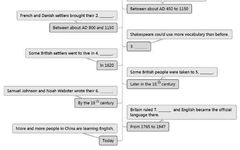
Mind maps, also known as mental maps, refer to the connection of various images through lines and symbols to establish relationships between concepts in an intuitive and visual diagram.With the continuous advancement of English curriculum reform, mind maps have been applied in English teaching, including vocabulary memorization, reading comprehension, listening, and writing, achieving some results.So how should they be specifically applied? Teachers Min Jiashun and Zou Qingrou have provided us with some insights from reading, listening, speaking, and writing. 1. Reading Teaching
1. Reading Teaching The widespread application of mind maps in expository and narrative texts helps improve students’ reading comprehension skills. Below, we will illustrate using the reading passage “The Road to Modern English” from the compulsory textbook for high school English, Unit 2 “English Around the World”.The article briefly explains the origin, development, reasons for changes, and trends of the English language. The first paragraph introduces the history of English development, the next two paragraphs discuss the historical reasons for English evolution, and the final paragraph covers the situation of English in African and Asian countries, as well as its development trends.The first question in reading comprehension is true or false, which contains a lot of information on time, place, characters, events, and logical details that need to be judged. It is clearly too difficult to ask students to make direct judgments without any assistance. Therefore, it is possible to consider setting up two steps as a prelude to this task to reduce the difficulty, gradually increasing the complexity:Step 1: Use flowcharts to assist skimming.From the content and sequence of the article, use the diagram below to clarify the order of relevant events in the development of English, only briefly omitting keywords so that students can focus on grasping the overall context of the article.
The widespread application of mind maps in expository and narrative texts helps improve students’ reading comprehension skills. Below, we will illustrate using the reading passage “The Road to Modern English” from the compulsory textbook for high school English, Unit 2 “English Around the World”.The article briefly explains the origin, development, reasons for changes, and trends of the English language. The first paragraph introduces the history of English development, the next two paragraphs discuss the historical reasons for English evolution, and the final paragraph covers the situation of English in African and Asian countries, as well as its development trends.The first question in reading comprehension is true or false, which contains a lot of information on time, place, characters, events, and logical details that need to be judged. It is clearly too difficult to ask students to make direct judgments without any assistance. Therefore, it is possible to consider setting up two steps as a prelude to this task to reduce the difficulty, gradually increasing the complexity:Step 1: Use flowcharts to assist skimming.From the content and sequence of the article, use the diagram below to clarify the order of relevant events in the development of English, only briefly omitting keywords so that students can focus on grasping the overall context of the article.
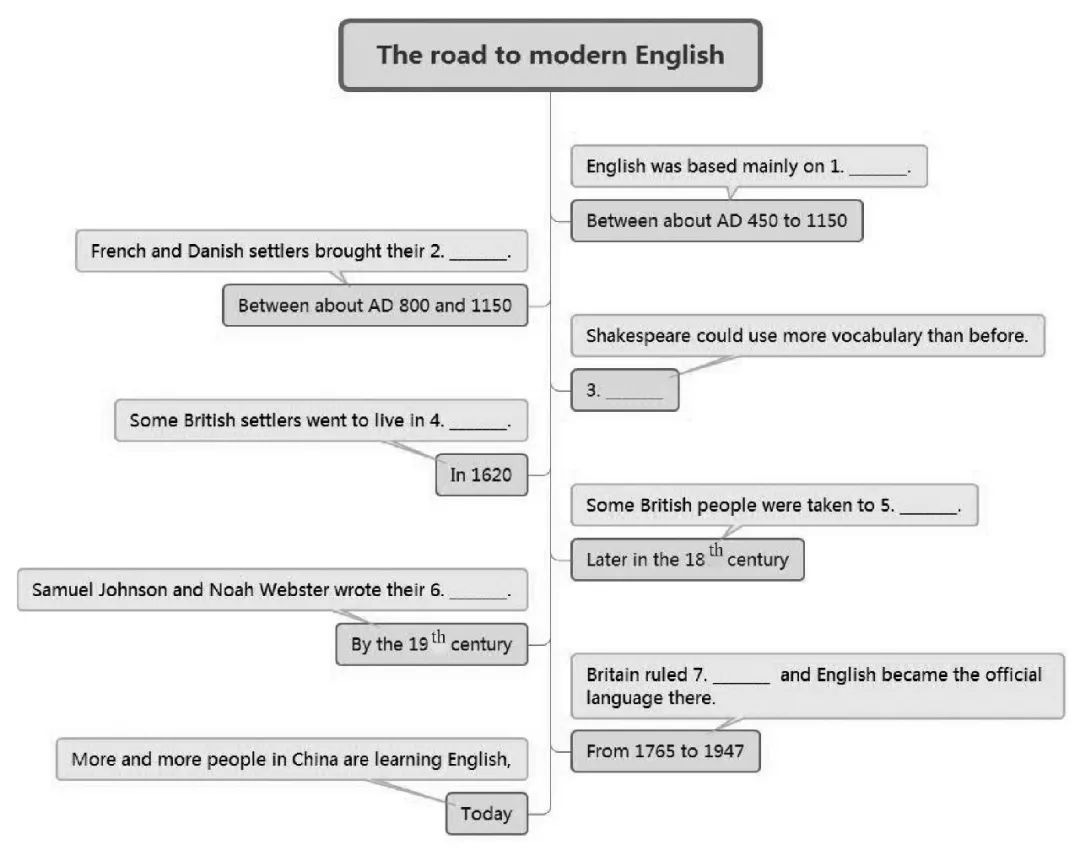
In this case, the statements of the events do not replicate the original sentences in the text but use synonymous transformations, such as transforming the original sentence “It was based more on German than the English we speak today.” into “English was based mainly on 1._______________. (the answer is German).”; Another example, the original sentence “So by the 1600’s Shakespeare was able to make use of a wider vocabulary than ever before.” is transformed into “Shakespeare could use more vocabulary than before.” to help students understand key sentences containing new vocabulary. Step 2: Event SequencingStudents, through skimming and using flowcharts, will sequence important events in the development of English.In this case, the statements of the events also used synonymous transformations, such as transforming the original sentence“The latter gave a separate identity to American English spelling.” into “American English had a separate identity in its spelling.”; another example, the original sentence “…because Britain ruled India from 1765 to 1949.” (followed by “During that time English became the language for government and education.”) transformed into “Britain ruled India for about 200 years.”, which provides hints for the source of answers in the true or false question “English is one of the official languages used in India.”From this, it can be seen that mind maps can help students understand the flow and structure of the article, organize the context during the reading task, and deepen their understanding of key sentences in the text.
Step 2: Event SequencingStudents, through skimming and using flowcharts, will sequence important events in the development of English.In this case, the statements of the events also used synonymous transformations, such as transforming the original sentence“The latter gave a separate identity to American English spelling.” into “American English had a separate identity in its spelling.”; another example, the original sentence “…because Britain ruled India from 1765 to 1949.” (followed by “During that time English became the language for government and education.”) transformed into “Britain ruled India for about 200 years.”, which provides hints for the source of answers in the true or false question “English is one of the official languages used in India.”From this, it can be seen that mind maps can help students understand the flow and structure of the article, organize the context during the reading task, and deepen their understanding of key sentences in the text. 2. Listening and Speaking Teaching
2. Listening and Speaking Teaching Taking the 2016 Guangzhou English listening and speaking test papers A and B as an example, Part B Role Play includes 10 questions:A: When will Cindy get annoyed? Why is Rachel’s pet store special? What do dogs depend on us for? What is harmful to a dog’s skin? What will help a dog enjoy learning?B: Where do the speakers live? Why does Jack hate ice on the sidewalk? What will Jack’s mother do next week? How much does a surfing course for beginners cost? Who will pick up Jack and his mother at the airport?Students are required to pre-draw a mind map with time (when or what time), place (where), characters (who), events and results (what), reasons (why), effects (how), and quantity (how many/how much) before listening, and purposefully and selectively fill in the relevant information into the corresponding keyword annotations during listening to increase the accuracy and correctness of their answers.
Taking the 2016 Guangzhou English listening and speaking test papers A and B as an example, Part B Role Play includes 10 questions:A: When will Cindy get annoyed? Why is Rachel’s pet store special? What do dogs depend on us for? What is harmful to a dog’s skin? What will help a dog enjoy learning?B: Where do the speakers live? Why does Jack hate ice on the sidewalk? What will Jack’s mother do next week? How much does a surfing course for beginners cost? Who will pick up Jack and his mother at the airport?Students are required to pre-draw a mind map with time (when or what time), place (where), characters (who), events and results (what), reasons (why), effects (how), and quantity (how many/how much) before listening, and purposefully and selectively fill in the relevant information into the corresponding keyword annotations during listening to increase the accuracy and correctness of their answers.
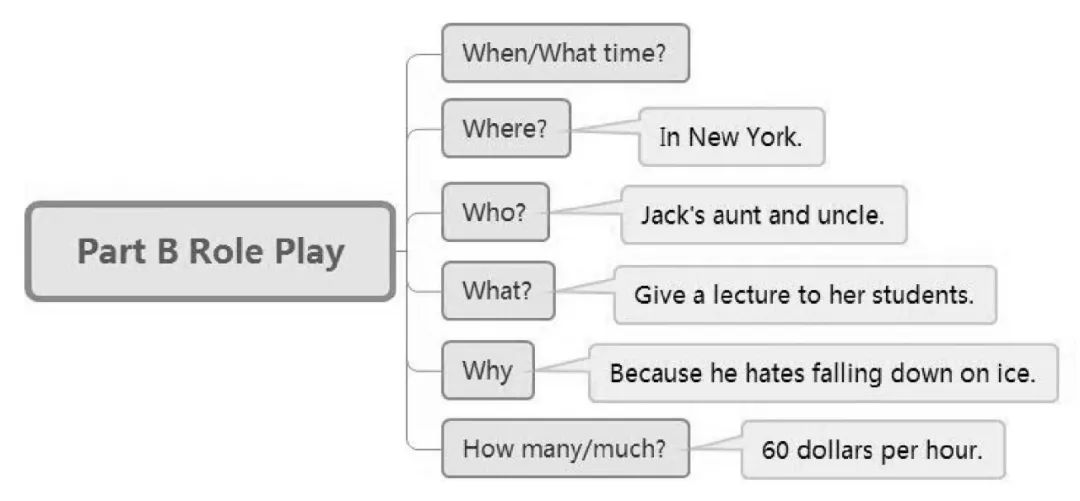
For Part C Retelling, a similar method can also be adopted, spreading out from the five given keywords, or using a logical diagram to spread out the five elements of the story: background, beginning, development, climax, ending while adding detailed information, and then connecting sentences to retell.
 3. Writing Teaching
3. Writing Teaching Among the four major language skills of listening, speaking, reading, and writing, Chinese students generally perform better in listening and reading than in speaking and writing, meaning that input skills are stronger than output skills, especially in writing, where what they can write and what they want to write are clearly two different levels.English writing usually faces two major challenges: what to write and how to write. With the reform of the new curriculum standards and the introduction of task-based teaching methods, English writing often involves open-ended and semi-open-ended topics. To address these two major challenges, teachers intentionally or unintentionally use the method of Writing Prompt in the actual writing teaching process, breaking down complex issues and concretizing abstract concepts, building a “scaffold” for students, helping students analyze the topic before writing, list key points, and structure their writing, while guiding them to check and revise after writing.Below, we will explore the general practices of high school English writing teaching using Writing Prompt in narrative writing as an example.
Among the four major language skills of listening, speaking, reading, and writing, Chinese students generally perform better in listening and reading than in speaking and writing, meaning that input skills are stronger than output skills, especially in writing, where what they can write and what they want to write are clearly two different levels.English writing usually faces two major challenges: what to write and how to write. With the reform of the new curriculum standards and the introduction of task-based teaching methods, English writing often involves open-ended and semi-open-ended topics. To address these two major challenges, teachers intentionally or unintentionally use the method of Writing Prompt in the actual writing teaching process, breaking down complex issues and concretizing abstract concepts, building a “scaffold” for students, helping students analyze the topic before writing, list key points, and structure their writing, while guiding them to check and revise after writing.Below, we will explore the general practices of high school English writing teaching using Writing Prompt in narrative writing as an example.
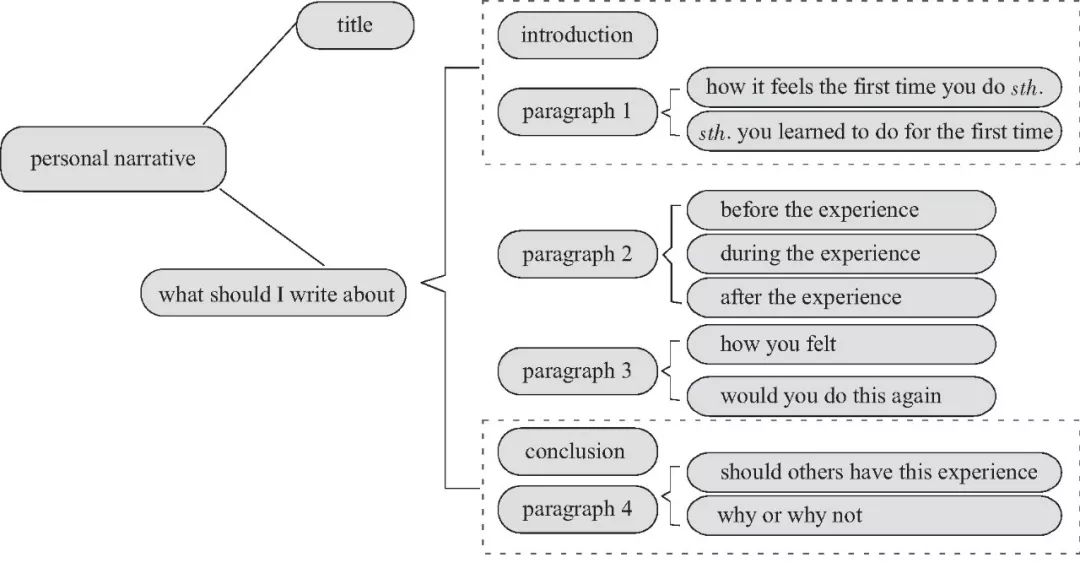
Step 1: Group Activity“Brainstorm” what to write, the textual part of the above mind map provides content prompts for each paragraph, mostly in the form of questions.Paragraph 1: How it feels the first time you do something, what you learned to do for the first time? Paragraph 2: Describe what happened before, during, and after the experience. Paragraph 3: How you felt, would you do this again? Paragraph 4: Should others have this experience, why or why not? Through thinking and answering these questions, students basically determine what to write and how to structure their writing, which is the writing outline. Step 2: Individual ActivityWrite according to the writing outline, connecting sentences to form a complete piece. The author appropriately provides commonly used words, phrases, sentence patterns, and conjunctions related to this topic based on the students’ situation. If time allows, students can first express orally, and then proceed to written writing, which can reduce difficulty and improve the accuracy of expression.Step 3: Partner ActivityCheck the completeness of the writing content, the accuracy and diversity of language, and the coherence of the text against the outline. Use different symbols to mark good words, good sentences, and spelling or grammar errors, or replace original general expressions with advanced expressions.Step 4: Individual ActivityAfter revising the article, copy it correctly and share it. The emphasis on copying is generally on maintaining consistent letter writing fullness, cutting lines, and slanting angles. If time allows, teachers usually organize a sharing activity of excellent works after writing, emphasizing and extending relevant knowledge.In addition to narrative writing, Writing Prompt is also applicable in argumentative essays, reflections, and other English writing.
Step 2: Individual ActivityWrite according to the writing outline, connecting sentences to form a complete piece. The author appropriately provides commonly used words, phrases, sentence patterns, and conjunctions related to this topic based on the students’ situation. If time allows, students can first express orally, and then proceed to written writing, which can reduce difficulty and improve the accuracy of expression.Step 3: Partner ActivityCheck the completeness of the writing content, the accuracy and diversity of language, and the coherence of the text against the outline. Use different symbols to mark good words, good sentences, and spelling or grammar errors, or replace original general expressions with advanced expressions.Step 4: Individual ActivityAfter revising the article, copy it correctly and share it. The emphasis on copying is generally on maintaining consistent letter writing fullness, cutting lines, and slanting angles. If time allows, teachers usually organize a sharing activity of excellent works after writing, emphasizing and extending relevant knowledge.In addition to narrative writing, Writing Prompt is also applicable in argumentative essays, reflections, and other English writing.
 In summary, mind maps are a teaching method advocated by curriculum reform, helping students build knowledge systems, diverge thinking, and improve summarization and induction abilities. Applying mind maps in English reading teaching can help students grasp the meaning of the text based on keywords, improving their analytical skills, reading abilities, speeding up their answering speed, and increasing their accuracy.
In summary, mind maps are a teaching method advocated by curriculum reform, helping students build knowledge systems, diverge thinking, and improve summarization and induction abilities. Applying mind maps in English reading teaching can help students grasp the meaning of the text based on keywords, improving their analytical skills, reading abilities, speeding up their answering speed, and increasing their accuracy. Mind Map of Junior High School Grammar
Mind Map of Junior High School Grammar
Click the image to view the full-size image

▲ Adjectives

▲ Adverbs
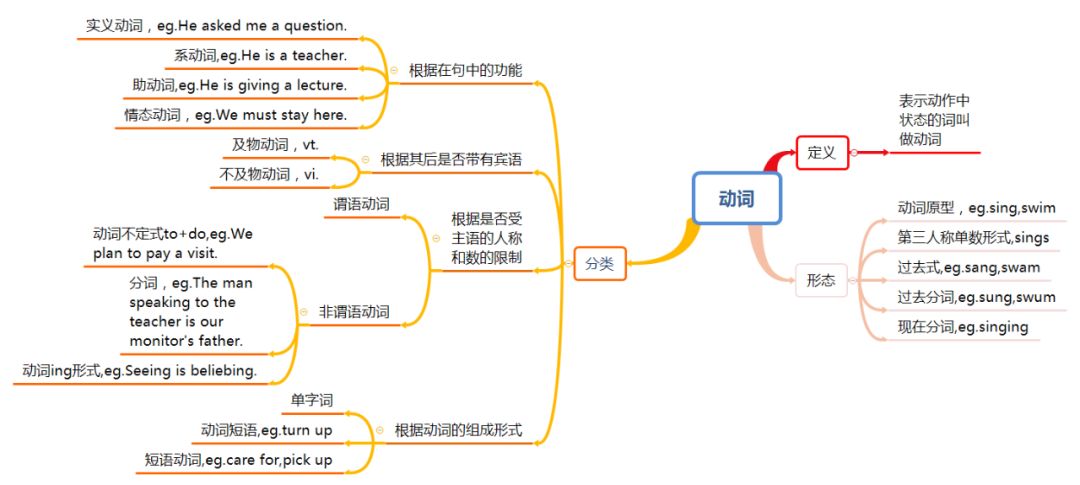
▲ Verbs
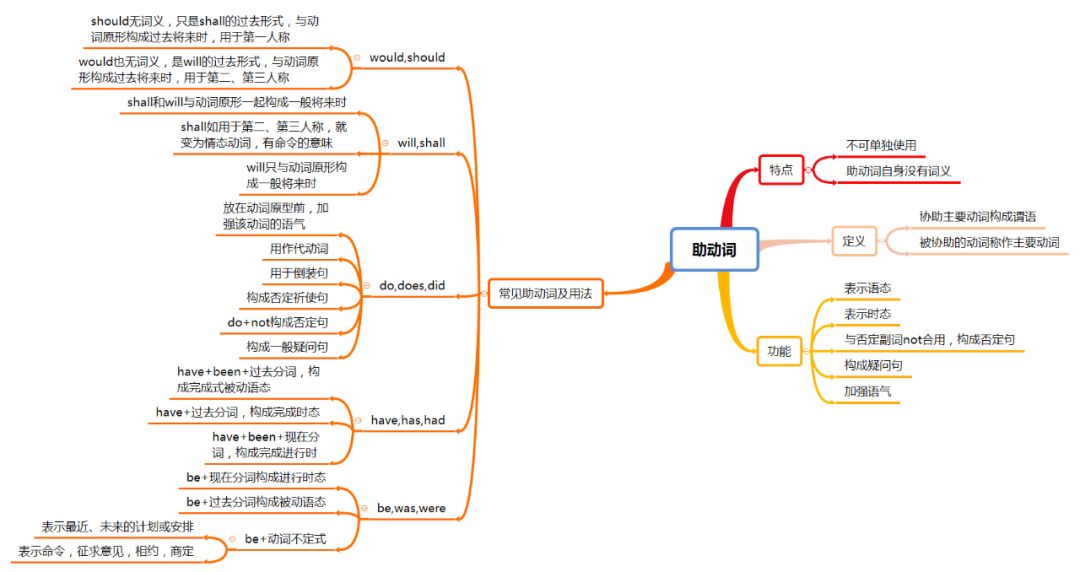
▲ Auxiliary Verbs
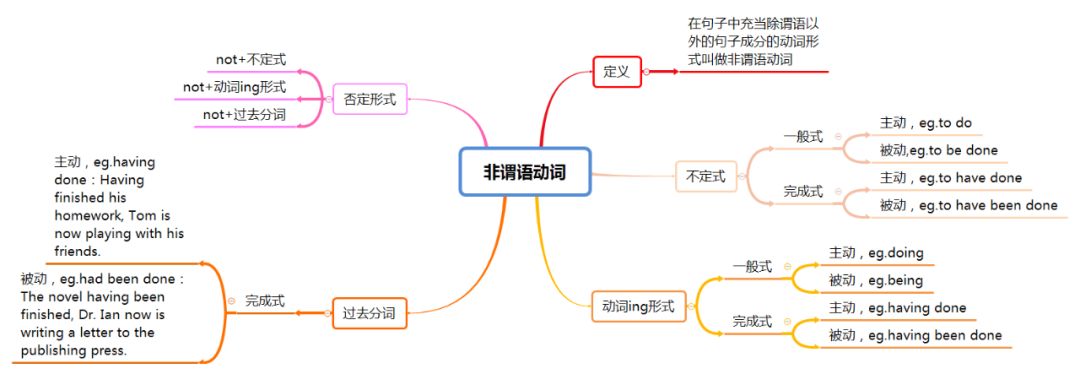
▲ Non-finite Verbs
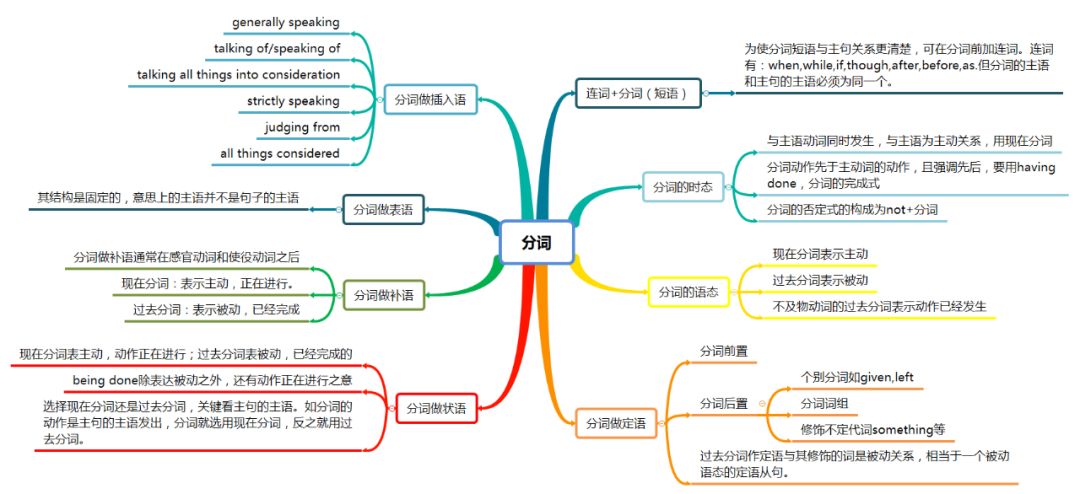
▲ Participles
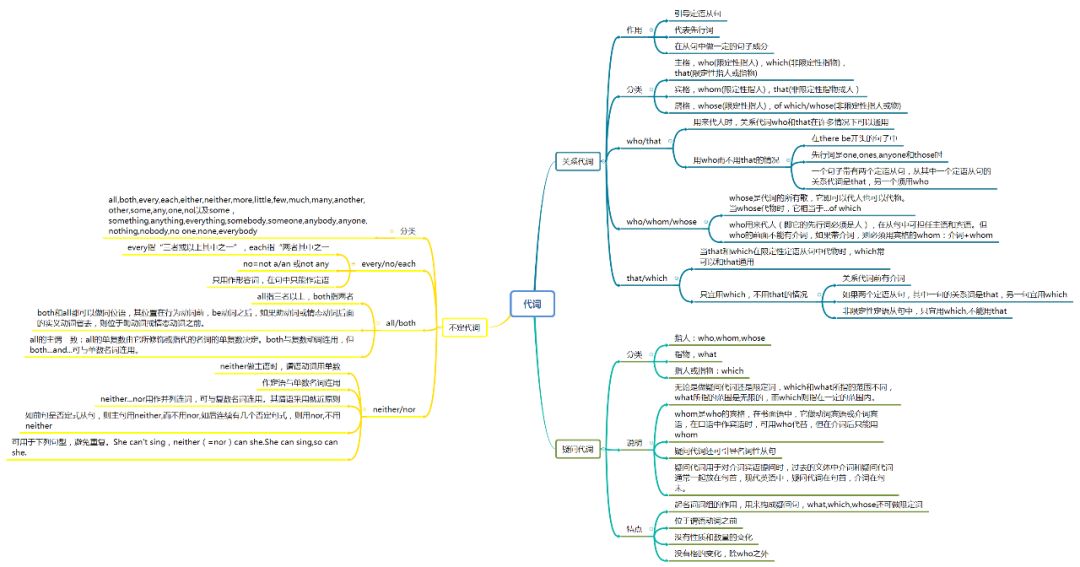
▲ Pronouns
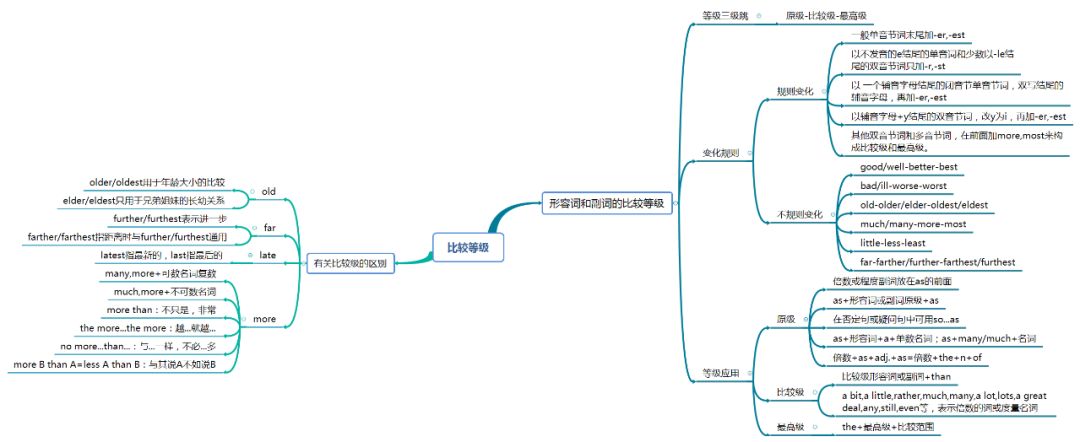
▲ Comparative Degrees

▲ Infinitives

▲ Infinitives as Subjects

▲ Infinitives as Complements

▲ Tenses and Voices of Infinitives

▲ Verbs without to in Infinitives

▲ Simple Present Tense

▲ Simple Future Tense

▲ Present Perfect Tense

References:
[1] Min Jiashun, Zou Qingrou. The Application of Mind Maps in High School English Teaching [J]. English Teacher, 2019, 19(04): 133-137.
[2] Tony Buzan. Mind Maps: Radiant Thinking [M]. Beijing: Writers Publishing House, 1988.
[3] Wang Xinyang. The Application of Mind Maps in Junior High School English Reading Teaching [J]. Foreign Language Teaching in Primary and Secondary Schools (Middle School), 2010 (05): 32-37.
